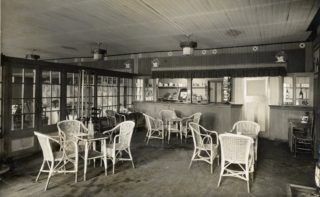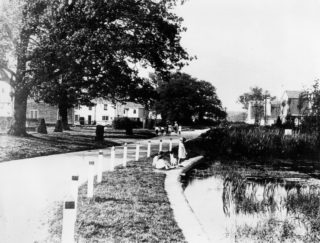Molly Jennings - Part Four
Welwyn Garden City's first resident
By Roger Filler
Continued from Part Three (recording made in 1969)
The Cherry Tree
The Cherry Tree came on the scene quite early in 1921 – not as we know it now, but a charming timber building with a larch-pole veranda, and come very dashing colour-decoration on the match-boarding inside.
It was opened with a grand concert, the first item being a duet, played by Mr Osborn and myself. There were songs by Mrs Hall, another pioneer who is still here, and Mr Jack Dent from Letchworth, and by Mrs Wood who was then Miss Stephens, the daughter of Mr Stevens, a railway official, who was living at 69 Handside Lane.
That was the first concert. The first social was held during the winter of 1920-21 in one of the huts in the workmens’s camp. There was dancing led by Mr Saunders, who is still in the Garden City, and, I believe, was in these parts before it ever began.
My mother took turns with Mr Huggett, one of the Accountant’s staff, at the piano, (By the way, I don’t dare to speculate about the age and pedigree of that piano. It was a miracle to find one there at all).
We all found our way across the fields and through the mud, all in gum-boots and with hurricane lamps to dodge the trenches and all the building paraphernalia. I suppose people must have ‘obliged’ with songs and other turns, and there must have been a competition, because I won a moonstone pendant!
There was no gas or electricity anywhere yet – we used oil for everything in our houses, and mostly logs for heating. There seemed to be an endless supply of those.
Anyone for tennis?
It seemed miraculous that there should be a tennis club that very first year – 1921 – but there was – two hard courts were made where Stonehills is now, and we had a grand time of it, with tournaments, tennis dances and so on, and we felt, and almost regretted, that we were beginning to get quite civilised
That summer, 1921, was the best I ever remember. There was no rain at all from February till October. We had moonlight picnics which went on most of the night, and dances and parties. Although we were so very free and easy, for some reason we turned out to parties in ‘faultless evening dress’. I think it was later, in 1923 – when one of these parties (Wyvil August’s 21st) finished up at 4am with a huge bonfire on the golf course (not then a golf course!) and on the way home two of the revellers were seen (still in not-quite-faultless evening dress) playing see-saw on a large plank and a barrel belonging to the scaffolding of number 3 High Oaks Road, which was just beginning to appear above ground, and one lady wearing a long lace frock, was wheeled home in the builder’s barrow.
Handside Pond
I had better draw a veil over the night when the Daily Mail Village sign was extinguished in the horse pond which used to be in front of the barn … or the cold January night when Mason and Mr Fox the Architect, who was already here working with Mr De Soissons, went skating on this same pond, and arrived home drenched in freezing green slime.
In 1921 a school was started in still another army hut for the children of some of these pioneers. A lady called Mrs Foulger was in charge of it, and when the numbers grew, my mother helped her.
I was still in the drawing office (another hut!). These huts were just on the edge of the woods, and we heard nightingales not only at night, but most of the day. This was a charming accompaniment to work, and there was sometimes competition from the next hut in the form of singing, games and nursery rhymes.
No running water
All the water at that time came from a well at the end of Handside Lane. There was some kind of arrangement which sent the water through our pipes, except for one week in the middle of that dry, hot summer when the machinery went wrong, and all the water came round in a cart. They dished us out two pailfuls a day per home, and that was when the hardened old campers scored.
On Sunday mornings at 6 or 7am a procession of enthusiasts used to set off on foot or on bicycles, and even in an open two-seater red car, home-made by Wyvil August and apparently held together with elastic and string. The expedition proceeded along the North Road, then straggled across the fields to bathe in the River Lea. At non-bathing times of the year, the same party went off in the opposite direction to pick mushrooms in the fields where the factories are now. The site of Guessens Court was a lovely grassy field where we picked large bunches of cowslips along the hedges.
The first play
The first play took place in the summer of 1921 in the large barn at Brickwall Farm. This was the “Showing Up Of Blanco Posnet”, produced by Mr Purdom. We were all roped in, whether we could act or not. I don’t know how many people were left to make an audience, but we all enjoyed ourselves, and this turned out to be the beginning of the Theatre Society. Various people turned up from Letchworth, including Elsie Colson, who took the part of the heroine (if that’s the right word). Elsie and her husband Frank came here to live soon after that, with their twins Melody and Marguerite. Frank was the kind of violinist one can never forget. He led the orchestra in the early days of the Music Society, and provided incidental music for many of the early shows, helped by Toby Elliston with his cello. I can’t remember who the pianist was – it may have been me.
The Music Society was the first to be formed. They gave a concert with chorus and orchestra as soon as the Old Parkway Hall was opened. Mr Sidney Sheppard was the conductor, and Miss Alice Hare the soloist – she was led on by the Conductor in real Queen’s Hall style. The only think I can’t remember is the name of the work which was performed – perhaps somebody can help me out with that.
Nibby, by the way, had a mother complex combined with a Houdini technique, for he turned up at every social, dance and party sooner or later, although he had been locked safely indoors when we left, We had to hide him under our chairs during the church service, which like everything else was held in a hut. He had the sense to keep quiet once he got there, except for a series of heavy sighs, and a strong smell of whatever happened to have been rolled in on the way. There was an unkind story started by Mr De Soissons that Nibby was once seen being chased by a rabbit.
The Belasco Cup
One of the highlights of early Garden City society was Ernest Selley. He was in the plays at Brickwall Farm, and a few years later he went to America with the company who won the Belasco cup with the play “Mr Sampson”.
Well, I don’t seem able to get much further than 1921. I wonder when I began, how I should be able to remember enough to interest anybody, but the problem seems to be rather to know where to stop. I expect I have left out many important people and amusing happenings, but perhaps as things occur to me I ought to go on with these jottings, or, better still, the tale may be taken up by other pioneers who have better memories.









Add your comment about this page
How lovely to read these memories. Although I came here in 1972 and was a nurse until 1983 when I started working for Welwn Hatfield Council, in the Leisure Division, I met many of the early members of Welwyn Garden City and their children. What an inestimable privilege it was.